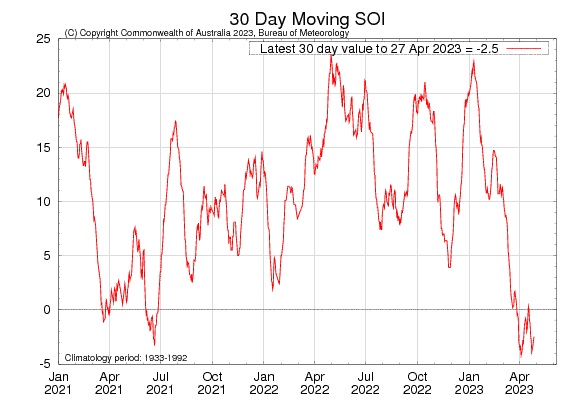 |
Weather Eye with John Maunder |
The Southern Oscillation Index (SOI) is a standardized index based on the observed sea level pressure differences between Tahiti and Darwin, Australia.
The SOI is a leading measure of the large-scale fluctuations in air pressure occurring between the western and eastern tropical Pacific (i.e., the state of the Southern Oscillation) during El Niño and La Niña episodes.
In general, smoothed time series of the SOI correspond very well with changes in ocean temperatures across the eastern tropical Pacific.
The negative phase of the SOI (El Nino) (represents below-normal air pressure at Tahiti and above-normal air pressure at Darwin.
The positive phase of the SOI (La Nina) represents above-normal air pressure at Tahiti and below-normal air pressure at Darwin.
Prolonged periods of negative SOI values coincide with abnormally warm ocean waters across the eastern tropical Pacific typical of El Niño episodes.
In contrast, prolonged periods of positive SOI values coincide with abnormally cold ocean waters across the eastern tropical Pacific typical of La Niña episodes.
Sustained negative values of the SOI below −8 often indicate El Niño episodes. These negative values are usually accompanied by sustained warming of the central and eastern tropical Pacific Ocean, a decrease in the strength of the Pacific Trade Winds.
Sustained positive values of the SOI above +8 are typical of a La Niña episode. They are associated with stronger Pacific trade winds and warmer sea temperatures to the north of Australia. Waters in the central and eastern tropical Pacific Ocean become cooler during this time.
The graph below ( from the Australian Bureau of Meteorology, BOM) shows monthly values of the SOI from January 2021 to 27 April 2023.

The ENSO Outlook (issued by the Australian Bureau of Meteorology ) in late April remains at El Niño WATCH. This means that while the El Niño–Southern Oscillation (ENSO) is currently neutral, there is approximately a 50 per cent chance of El Niño developing in 2023. This is about twice the normal likelihood.
A significant amount of warmer than average water exists in the sub-surface of the western and central tropical Pacific Ocean, and warm sea surface temperatures (SST) anomalies continue to strengthen in the eastern tropical Pacific. The Southern Oscillation Index (SOI) has decreased to negative values over the past fortnight. Warming ocean temperatures in the eastern and central tropical Pacific and decreasing SOI values can be a precursor of El Niño development.
El Niño WATCH is not a guarantee that El Niño will occur, rather an indication that some of the typical precursors are currently occurring. All climate models surveyed by the Bureau suggest that El Niño thresholds are likely to be approached or exceeded during the southern hemisphere winter.
*****
El Nino and La Nina weather over New Zealand (Source Niwa)
During El Niño, New Zealand tends to experience stronger or more frequent winds from the west in summer, typically leading to drought in east coast areas and more rain in the west.
In winter, the winds tend to be more from the south, bringing colder conditions to both the land and the surrounding ocean.
In spring and autumn south–westerly winds are more common.
La Niña events have different impacts on New Zealand's climate. More north–easterly winds are characteristic, which tend to bring moist, rainy conditions to the north–east of the North Island, and reduced rainfall to the south and south–west of the South Island.
Therefore, some areas, such as central Otago and South Canterbury, can experience drought in both El Niño and La Niña.
Warmer than normal temperatures typically occur over much of the country during La Niña, although there are regional and seasonal exceptions.
Although ENSO events have an important influence on New Zealand's climate, it accounts for less than 25 per cent of the year to year variance in seasonal rainfall and temperature at most New Zealand measurement sites.
******
For further Infomation about a wide range of weather/climate matters see my new book Fifteen shades of climate... the fall of the weather dice and the butterfly effect.
Just Google 'fifteen shades of climate” for details.

